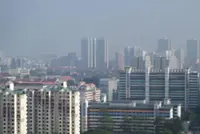JAKARTA (Reuters): The perennial issue of transboundary haze has again sparked friction in Southeast Asia, with Malaysia's environment minister writing to the Indonesian government this week calling for a regional response to the toxic smoke drifting across his nation.
The letter comes just weeks after countries in Southeast Asia committed to a haze-free region by 2030.
What's going on?
In recent weeks air quality in parts of Malaysia and Indonesia has spiked into the red, with indexes consistently showing readings above 150 - putting it in a bracket where people can experience health effects, and those with sensitive conditions could suffer more serious problems.
On the Indonesian side of Borneo island visibility was reduced to less than 10 metres, while schools have been shut in both Indonesia and Malaysia to minimise the health impact on young children.
Malaysia has blamed the haze on Indonesia, saying that smoke from forest fires drifts over the border.
Every few years, during the dry season, smoke from "slash and burn" land clearing, largely to make way for oil palm, pulp and paper plantations, engulfs much of the region, posing a threat to public health, education and businesses such as tourism.
How is the problem being addressed?
Despite pleas by Malaysia this week not to "normalise" the haze, Indonesia has flatly denied any responsibility.
Indonesia's environment minister Siti Nurbaya Bakar said on Friday that forest fires had declined and no haze was detected moving toward any neighbouring country.
Indonesia has been addressing the fires by water bombing via helicopters, she said.
Indonesia has in the past taken legal action against companies suspected of illegal burning, but each year fires continue with varying degrees of severity.
In 2015 and 2019 Indonesia was struck by catastrophic blazes that burned millions of hectares of land, causing record-breaking emissions and engulfing some places in toxic yellow smoke.
Why does this keep happening?
Under Indonesia law burning by small-scale local farmers is permitted provided it occurs on a maximum area of two hectares and necessary prevention measures are in place.
All large-scale planters are obligated to comply with sustainable palm oil standards, which prohibit burning.
The regulations mean that slash and burn techniques continue to be used by small-holder farmers who rely on the cheap land clearance method and for whom compliance to the standards is voluntary.
Opaque supply chains, overlapping land claims and these regulatory loopholes mean that large companies, which are in some cases owned by firms based in countries such as Malaysia and Singapore, can sometimes avoid responsibility for illegal land clearance.
How is the region responding?
The Association of Southeast Asian Nations recently launched a coordinating centre for Transboundary Haze Pollution Control (ACC THPC).
Intended to help members prevent, mitigate and monitor transboundary haze, the centre is in line with Asean's commitment to achieve a haze-free region by 2030.
This week Asean agriculture and forestry ministers also agreed to take collective action to minimise and eventually eliminate crop burning.
Is climate change making it worse?
Indonesia is home to the world's third largest rainforest area and the government needs to take more action, environmentalists say. The country is experiencing exacerbated dry conditions due to the El Nino weather pattern this year.
Greenpeace Indonesia says climate warming is increasing the intensity and frequency of forest and land fires, which are in turn fuelling the climate crisis.
Why palm oil?
Global consumption of palm oil, used in a wide range of products such as cookies, candles and as a cooking oil, is growing rapidly.
Palm oil is the world's most used edible oil, accounting for 60% of global vegetable oil exports.
For Indonesia, the world's biggest palm oil producer, the product is one of the biggest export earners after coal. Export earnings from palm oil and its derivatives stood at $39.28 billion in 2022, according to the Indonesian Palm Oil Association.
(Reporting by Ananda Teresia and Kate Lamb, Additional reporting by Bernadette Christina; Editing by Naveen Thukral and)








































